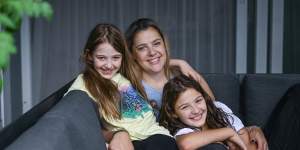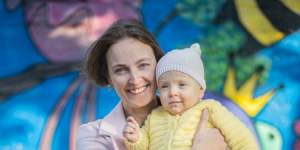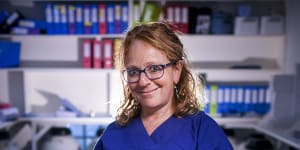“That is one of the hardest things about being diagnosed with something life-altering at a young age,” says Creus,now 44.

Vali Creus with her 10-year-old twins,Alexis and Kaia.Joe Armao
“I was young and had all these plans for the future,which then suddenly you’re faced with the possibility of never being able to achieve.”
Creus’ oncologist,Professor Tom Jobling,decided to preserve her remaining ovary in case of a breakthrough,and it’s thanks to this that she recently celebrated the 10th birthday of her adored twins,Kaia and Alexis,with her husband,Dean.
The girls are sports-mad like their mum,love reading and are interested in science. They were conceived in a world-first procedure when Associate Professor Kate Stern and her team at the Royal Women’s Hospital successfully re-implanted a tiny,thawed fragment of Creus’ ovary – which had been frozen for about 10 years – into her abdomen,and it began to produce eggs.
“We got married about three months after I had my first operation to re-implant the tissue,then[after it produced eggs] did 17 cycles of IVF,” says Creus,who is payroll manager at retail chain David Jones.
“I’m pretty stubborn and managed to get pregnant with twins. They just turned 10,which is insane … they are tall and full of energy and crazy.”
This year,Stern and her team at Melbourne IVF will try to take the research that brought Creus’ hopes to life one miraculous step further by growing viable eggs outside the body from preserved ovarian tissue.
They are working with research colleagues in Belgium and Vietnam on a technique that could provide pre-pubertal girls with a stronger chance to go on to have babies that are genetically their own after cancer treatment.
The technique could also help those with little time to undergo conventional egg retrieval via stimulated cycles,and other women whose fertility is at serious risk,by providing a way to make a large number of eggs without taking artificial hormones for weeks or months.

Sarah,with her baby Etta,is among the women who have had babies via ovarian grafting following cancer treatment.Simon Schluter
If it can be achieved,“it gives you the potential of hundreds of eggs,whereas egg freezing,which takes two weeks,might give you a limited number of eggs,” says Stern,whose previous work on ovarian grafting has led to the birth of 15 babies.
“Because it’s tissue[containing perhaps hundreds of potential egg follicles] it gives you a substantial number of opportunities with eggs both in the body and in vitro to achieve fertility.”
The knowledge gained during the process that led to Creus’ pregnancy has paved the way for developments that could help many other women,said Stern. The latest advances could be useful for patients with many types of fertility issues,not just for preservation.
“We from Vali’s case … we’ve really learned and evolved;now what we’re interested in doing is trying to … make it more efficient and safer to use eggs from tissue,which could include getting the follicles out of the tissue,maturing them outside the body,and then you can do IVF,” Stern said.
With ovarian grafting,“you put tissue back and see if it works,and might be lucky if you get one egg a month,while this new technology is an opportunity to get lots of eggs at the one time”,she said.
Fertility specialist Professor Louise Hull of Adelaide’s Women’s and Children’s Hospital and the Robinson Research Institute said it could provide a way for some of her future patients to retain fertility.
“It[fertility preservation] is very tricky for young girls,particularly those who need total body irradiation,they are almost certainly not going to have any eggs left at the end of that – but probably a good prognosis[for their illness],” Hull said.
“This is a way of being able to help them have a child at a later date. Currently,we in-graft,which doesn’t work for some groups. I think this is the way of the future,really.”

Associate Professor Kate Stern is working on a way to create large numbers of eggs in the lab from tiny pieces of thawed ovarian tissue.Eddie Jim
Hull sends tissue from her cancer patients to Stern’s group in Victoria,“because their techniques are so good … we send two or three a month that would utilise that service”. The new technique would “give a lot of people a lot of options”.
“At the moment from in-graft tissue you only get one egg a month if you ovulate,this would give you many more chances.” It would also remove the risk of cancerous cells being re-introduced to the bodies of women who have had leukaemia.
Senior research fellow at Melbourne IVF,Dr Alexandra Harvey,said the work was receiving support from across the world,and she hoped more cancer survivors were made aware that tissue could be flown from anywhere in Australia to be preserved. Seeing babies such as Alexis and Kaia born at the end of such projects was thrilling,she said.
“We do see some of the end results,which is really nice,” Harvey said. “It means the world to us because we’ve been part of the process at every step,it is always amazing.”
Make the most of your health,relationships,fitness and nutrition with our Live Well newsletter..